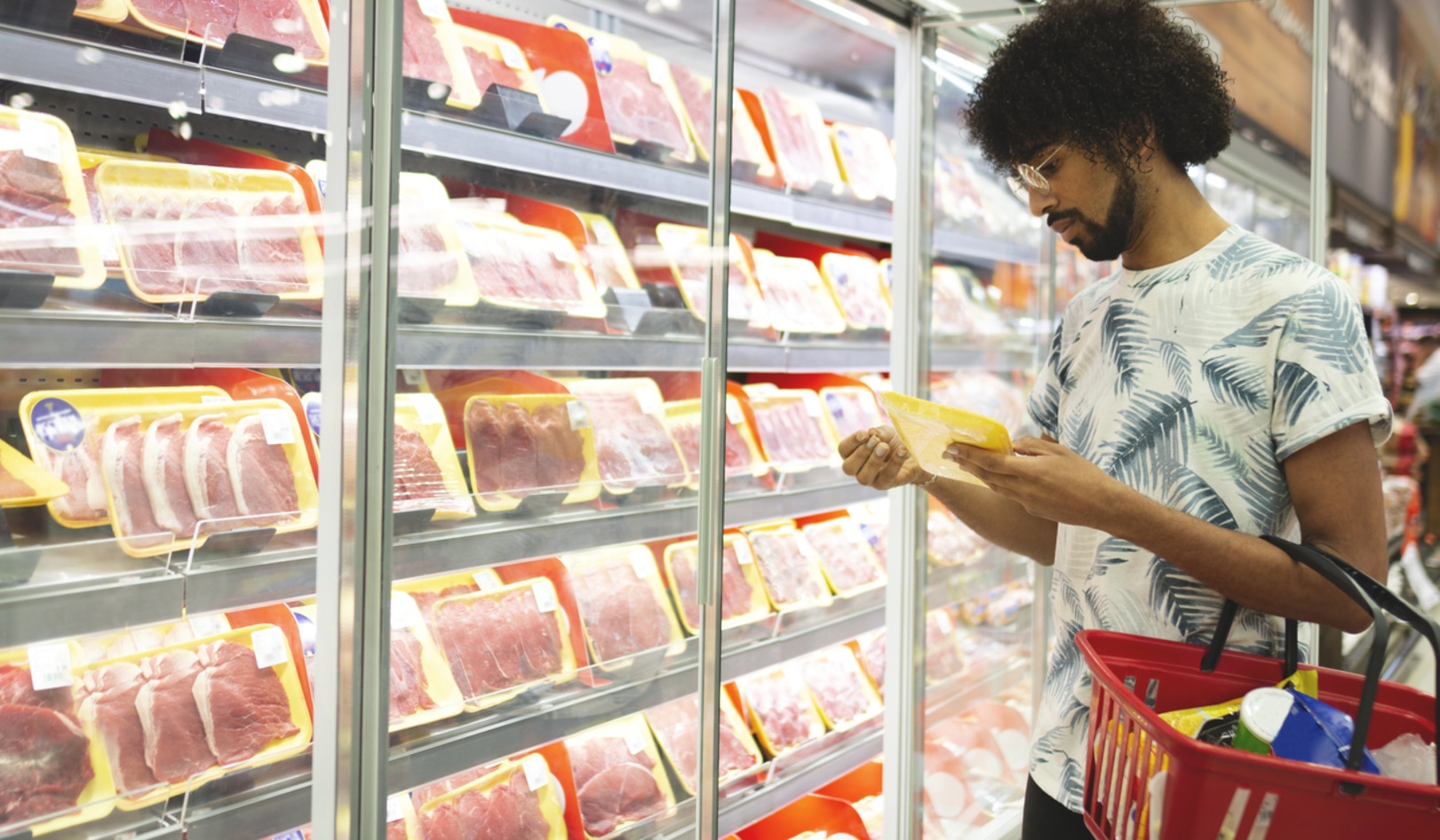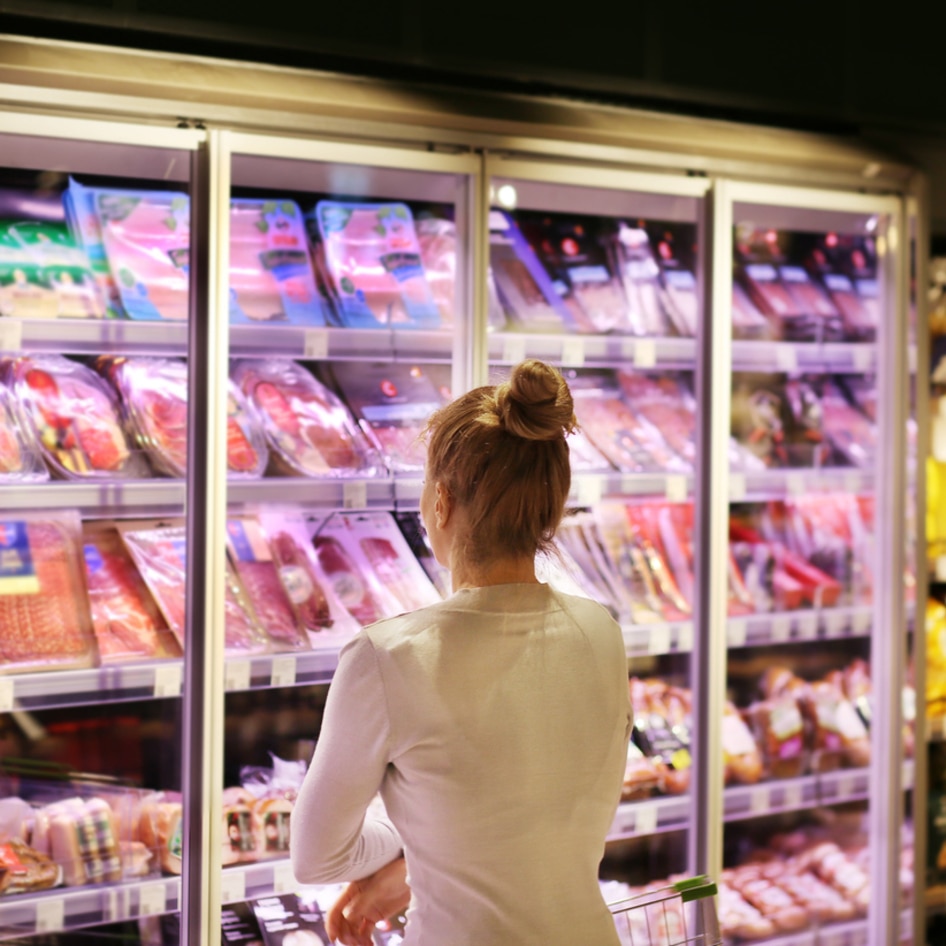Inside the Life of a Factory Farm Worker
Writer Mark Hawthorne investigates the animals whose rights we often overlook when trying to live compassionately: humans.
April 30, 2013
This story originally ran in the March+April 2011 issue of VegNews. For the full article, pick up a copy of the magazine in the VegNews Store.
For much of the past three years, Alex Bennett has had one of the most miserable jobs in one of the most dangerous industries in the country. As a chicken hanger in a poultry slaughterhouse, Bennett (not his real name) hoists fully conscious birds by their feet and locks them upside down into shackles along a fast-moving line that leads the chickens to an electric stun bath—and then to a mechanical blade that cuts their throats. “You have to be able to hang about 35 birds a minute,” he says, “even as the muscles in your hands and the joints in your fingers become so sore that you cannot open and close your hands.” Repeatedly handling the metal shackles results in open wounds that cover Bennett’s knuckles, but that’s not the worst of it.
The terrified chickens fight back, pecking and biting the hangers. In the end, locked in place and their defenses exhausted, the birds empty their bowels. “You wear hair nets, you wear beard nets, you wear goggles, you wear face masks, you wear an apron, you wear boots,” says Bennett. “They have these things that are like garbage bags that are made into sleeves with elastic ends, and you put these over your arms, tucking them inside your gloves.” Despite the protective coverings, he says, feces from the frantically flapping birds ends up everywhere. “It gets into your eyes, your nose, your mouth, your ears. There is no adequate description of what it’s like to stand on the line for hours and have the chickens defecate all over you. The fecal matter hits you under your clothes, and you can feel it slowly running down your body. It doesn’t matter how much clothing you wear or how much tape you use, it’s still going to happen. It’s absolutely inevitable.”
Nothing slows the line—not chicken excrement, not tired workers, not injured hands. In some slaughterhouses, not even an urgent need to answer the call of nature can interrupt production. “At the Tyson plant I worked at,” says Bennett, “the workers were actually urinating right on the equipment—on the poles and beneath the live-hanging conveyor belt that brought the birds in from outside.” It’s not uncommon for slaughterhouse workers to defecate in their pants, lest they slow the system that destroys 10 billion lives a year in the US. Bennett sighs with resignation. “They expect you to do what you have to do in order to keep working.”
No one enjoys slaughterhouse work; it’s grueling, violent, dangerous, and repetitive. There aren’t many people—even hardcore meat-eaters—who could tolerate the viscera and the frenzied pace, and with an average wage of $11.42 an hour ($23,753 a year), many meatpackers struggle to provide for their families. Those in the veg community, meanwhile, may find it especially difficult to generate any sympathy for anyone who participates in a system that commodifies sentient beings. And yet, ethical eaters may want to regard the exploitation of slaughterhouse workers as another reason to embrace vegetarianism.
It’s Still a Jungle Out There
Asked to consider their motive for choosing a plant-based diet, most vegetarians would likely cite health or concern for animals. A growing number of consumers are also recognizing how their food choices impact the environment. But less publicly known or understood is the physical, psychological, and financial toll endured by those who work the nation’s animal-disassembly lines. For these men and women, detaching themselves from the large-scale death they’re actively involved in becomes a matter of survival. “In many slaughterhouse jobs, brutalizing animals or cutting them apart becomes so routine that within days, or in some cases only hours, I have found myself listening to screams as background noise and thinking of struggling animals as problems to overcome,” says Mike Smith (whose name has also been changed).
The gruesome process of turning frightened animals into food has a lasting effect on slaughterhouse employees that transcends the killing floor. “Most workers become deadened to the fact that they are working with live animals,” says Gail Eisnitz, whose 1997 book Slaughterhouse: The Shocking Story of Greed, Neglect, and Inhumane Treatment Inside the US Meat Industry demonstrates that farmed animals are not the only victims in food production. “Many of the individuals I interviewed described suffering from alcoholism, while others explained that they had taken out their frustrations through physical violence directed at their wives and children.”
Yet trying to cope with the pain they inflict on others is only part of what workers endure. More than 100 years after Upton Sinclair’s novel The Jungle took readers into Chicago’s packinghouses for an unflinching meet-your-meat experience, butchering animals remains a hazardous way to make a living. “Meatpacking is the most dangerous factory job in the United States,” says Cornell University labor expert Lance Compa. “That’s based on injuries that lead to lost time at work and injuries that lead to death. There’s a huge incidence of people cutting themselves and cutting each other.”
A 2009 survey of 455 meatpackers conducted by Nebraska Appleseed, a nonprofit dedicated to equal justice, depicts an industry where demand for speed fuels injury and verbal abuse. The report found that the speed of production lines in slaughterhouses has increased even as the number of employees has dropped. Faster line speeds and fewer workers mean higher profits for the handful of corporations that now dominate the meat-production industry. Supervisors subject workers who fall behind to humiliation and even screaming. “They scream at you a lot,” says one worker from the survey. “When supervisors talk to you, they scream at you and insult you, using obscenities,” says another. “There is no respect for the workers.” The line has become so rapid that workers often don’t even have time to properly sharpen their knives; instead, blades are routinely honed by scraping them on the slaughterhouse floor, says Norman Pflanz, staff attorney with Nebraska Appleseed.
Faster lines also mean greater risks. “We’re talking double the injury rate of the US industry as a whole.” Even a highly automated industry like meatpacking can find no substitute for the precision of the human hand, and over the decades the work has become increasingly mindless, with people executing the same motion thousands of times a day. In a plant processing as many as 400 cows per hour—which is now an industry standard—exhausted workers trying to keep up with the unrelenting pace routinely suffer lacerations or crippling repetitive-motion injuries (RMI) such as carpal tunnel syndrome and tendonitis of the hands and wrist from performing as many as 10,000 of the same cuts in a single shift—that’s one cut every 3 seconds. The rate of RMI among meatpackers is more than 30 times higher than the national average in industry. And because cattle come into the slaughterhouse with widely varying sizes, there is no standardized equipment to handle them uniformly and safely. The US Department of Agriculture is the sole entity responsible for regulating the velocity of production lines, and they monitor them to protect the consumer, not the worker. Speed limits are set to allow inspectors just enough time to check animals for contamination or disease.
Fear Factories
In his bestselling exposé Fast Food Nation: The Dark Side of the All-American Meal, investigative journalist Eric Schlosser explains how the industrialization of meatpacking has created an unskilled workforce of impoverished immigrants. Producers such as Tyson Fresh Meats (formerly IBP), the world’s largest meatpacker, have actively recruited workers from Mexico and Central America while also encouraging these new employees to invite friends and family to apply for work. A growing percentage of this workforce is comprised of undocumented laborers (their exact number is unknown, but 38 percent of slaughterhouse workers were born outside of the US), and the ever-present threat of deportation keeps many of them, for whom even a bad job is a job, silent and disempowered. Most are economic refugees—pushed north out of desperation—and they do not understand they have rights, such as workers’ compensation benefits to cover work-related injuries. “The workers’ comp claim forms look intimidating, especially to people who don’t speak English and can’t read any language,” writes Schlosser. “Filing a claim, challenging a powerful meatpacking company, and placing faith in the American legal system requires a good deal of courage, especially for a recent immigrant.”
And meat producers know that. According to a 2005 study by the nonprofit Human Rights Watch (HRW), the meatpacking industry discourages unions and promotes a culture of fear. “I am sick at work with a cold and breathing problems, and my arms are always sore,” a Smithfield Foods worker from Chiapas, Mexico, says in the report. “I have red rashes on my arms and hands, and the skin between my fingers is dry and cracked. I think I have an allergic reaction to the hogs. But I am afraid to say anything about this because I’m afraid they will fire me.” HRW’s report is highly critical of the industry, concluding that working conditions are so appalling they violate international human rights.
Lance Compa, lead author of the HRW report, says that even amid a dreadful work environment, many employees worry they will be replaced. “I interviewed lots of workers in these factories. A lot of them were undocumented, and they say, ‘I don’t want to do anything that would get me in front of legal authorities. I don’t want to write an injury report, I don’t want to file a wage and hour claim, I don’t want to organize a union—I don’t want to do anything that is going to have someone possibly investigate my immigration status.’ So the fear factor is enormous.”
Workers may be more inclined to come out of the shadows if they better understood their rights. According to the Universal Declaration of Human Rights, the International Covenant on Civil and Political Rights, and other standards adopted and proclaimed by the United Nations and signed and ratified by the United States government, all workers, regardless of their citizenship status, are to be granted a safe and healthy workplace, compensation for workplace injuries and illnesses, freedom of association, the right to form trade unions and bargain collectively, and equality of conditions and rights for transnational workers. Advocacy groups such as Rights Watch, Nebraska Appleseed, and others point to systemic violations in workplace health and safety, workers’ compensation, workers’ organizing rights, and the status of immigrant employees. “Workers are not informed of their workers’ compensation rights,” says Pflanz. “Here in Nebraska, for example, a worker has an absolute right to see their own physician or the physician of their next of kin—they have to be informed of that. A lot of times they are being sent to these company doctors who completely downplay the injuries that are presented to them. A lot of these companies are tricking the workers, telling them, ‘We’re going to take care of this right now.’ They are not informed of their rights, and their compensation is greatly reduced because of the physician they are funneled to.”
No Age Requirement
Slaughterhouses do not officially hire employees under 18, but the meatpacking industry has been known to attract underage workers, especially in rural areas where jobs may be scarce. In the 1980s, for example, the Monfort slaughterhouse in Garden City, Kans., was even advertising for workers in the high school newspaper. In 2008, federal authorities raided a poultry slaughterhouse in South Carolina and found juveniles as young as 15 performing hazardous jobs alongside adults.
Last year, when the former CEO of Iowa kosher slaughterhouse Agriprocessors was found not guilty of charges that he had hired underage workers, it was a startling legal upset. That Agriprocessors operated on child labor, exposing young workers to dangerous chemicals, meat grinders, and circular saws, wasn’t in dispute; dozens of former employees under 18 years old testified during Sholom Rubashkin’s trial that they had worked for Agriprocessors. Two years earlier, five of the company’s executives were charged with 9,311 child labor violations. Rubashkin was acquitted because all of the children, mostly immigrant teens, allegedly claimed to be 18 when they applied for their jobs. The case has drawn international attention to the exploitation of children in the meatpacking industry; though acquitted of child-labor violations, Rubashkin is currently serving 27 years on financial fraud charges stemming from his tenure at Agriprocessors.
Plant-Based Peril
The horrific working conditions endured by slaughterhouse workers alone are enough to make anyone go vegetarian. Contributing not only to the barbaric slaughter of sentient animals but also to the virtual enslavement of other humans is perfect cause for foregoing flesh. But turning to a plant-based diet isn’t the end of the line when it comes to stopping suffering. Another group of workers need to be considered, as their lives mirror the constant uncertainty, fear, and grueling labor of slaughterhouse workers. The men, women, and children who plant, cultivate, harvest, and pack fruits and vegetables, and struggle to eke out a living amid fields of toxic agricultural chemicals, employer harassment, and often extreme temperatures. Already among the most disadvantaged groups in the country, migrant and seasonal farm workers—that is, those who move from one location to another in search of agricultural work and those who perform farm work in their local area when it is in season—face harsh living conditions, low pay, and backbreaking labor.
The perils of produce work grabbed national headlines in May 2008, when María Isabel Vásquez Jiménez, a 17-year-old farm worker from Oaxaca, Mexico, passed out while pruning grape vines for $8 an hour near Stockton, Calif. Perhaps unaware she was two months pregnant, Jiménez was toiling in 101-degree heat without shade and with limited access to drinking water when she collapsed. After some ineffectual first aid, the farm’s labor contractor released her to her boyfriend, Florentino Bautista, who drove Jiménez to a local clinic. But before Bautista drove off, the contractor advised him to tell medical staff that his girlfriend had been exercising, not working in the vineyard, when she became ill. He also told him to say the underage laborer was 18. Staff at the clinic immediately recognized the serious nature of the stricken farm worker’s condition and transferred her to a hospital, but it was too late. Her body temperature spiking at 108 degrees, she lapsed into a coma and died two days later from heat stroke.
“Within the work process there’s a built-in conflict, because there’s a lot of pressure to be productive and work quickly—particularly if you’re working piece rate or under some kind of production quota, where you have to fill a certain number of boxes per hour each day,” explains Anne Katten of the California Rural Legal Assistance Foundation, a nonprofit legal services program. Such pressure can make workers very reluctant to take even their regularly scheduled breaks and short breaks to get water, let alone extra breaks to get out of the sun, she says. “I have heard of employers who have been very innovative about getting shade out to the field and encouraging workers to drink a lot of water. On the other hand, I’ve heard of employers who really pressure workers not to take breaks at all.” Jiménez’s death wasn’t the first time an agriculture laborer had died from a heat-related illness after working a produce field, and it wasn’t the last—there have been 12 such deaths in California in the past five years.
Fields of Injustice
Trouble is, it takes more than an occasional public drubbing to get produce companies and the labor contractors they retain to comply with the law—when a law exists. In the 20th century, agricultural laborers were excluded from most of the major laws passed to protect workers. The Fair Labor Standards Act of 1938, for example—which banned child labor, established a minimum wage, and discouraged long work hours—contains a number of exclusions that effectively exempt seasonal farm workers. Amendments to the Act eventually prohibited children under 16 from engaging in certain hazardous work in agriculture and have extended the federal minimum wage to most farm laborers, but companies easily get away with paying their workers lower wages, and there is still no overtime provision. Farm workers are further marginalized by being excluded from the National Labor Relations Act of 1935, which doesn’t even define them as “employees,” says María Martínez of the New Mexico Center on Law and Poverty. Consequently, they are not granted many traditional workers’ rights, including collective bargaining through the formation of a union. “There’s so much exploitation in the agricultural industry, it’s ridiculous,” says Martínez. “A lot of workers just take it because they’re fearful of losing their job.”
Adding injury to insult, without adequate legal rights, farm workers engage in one of the most dangerous occupations in the country. In addition to potentially lethal temperatures, workers cope with lacerations, respiratory diseases, melanoma, and noise-related hearing loss. Laborers on non-organic farms are invariably exposed to agricultural chemicals, as pesticides, arsenic compounds, synthetic fertilizers, solvents, and other toxic substances, liberally used in the production of conventional fruits and veggies. The potential long-term, chronic effects of coming into contact with these chemicals include prostate cancer, leukemia, neurological deficits, fertility problems, and serious birth defects. According to the Food Empowerment Project, as many as 20,000 US farm workers are diagnosed with agricultural-chemicals poisoning every year. “Exposure to agricultural chemicals is one less hazard workers have to endure on organic farms,” says Lauren Ornelas, the program’s executive director. “This is one reason we encourage people to buy organic fruits and vegetables, although it’s similar to the situation with organic milk and eggs: the ‘organic’ label does not mean the animals are treated any better. We realize that is not as easy as asking someone to go vegan, but it’s one way we can stand up for the people who grow our food.”
Ultimately deemed disposable by their employers, migrant and seasonal farm workers are a medically vulnerable group facing a host of barriers that make getting ill especially daunting. Even if they have access to healthcare—and few do—they often lack the transportation needed to seek treatment. Like undocumented workers in the meatpacking industry, farm workers residing in the US without documents routinely encounter the threat of deportation should their status become known, so they avoid health professionals. Those who do visit a doctor are generally so economically disadvantaged that paying for services becomes yet another burden. The National Center for Farmworker Health states that nearly 90 percent of their patients have no health insurance and are at or below the federal poverty level.
Perhaps the most insidious danger is the persistent menace of sexual harassment and physical violence that female laborers face. Most of the women interviewed for a 2010 study by the Southern Poverty Law Center, a nonprofit civil rights organization, reported enduring harassment that rose to the level of sexual assault while working in agricultural fields or slaughterhouses. Sexual predators regard undocumented women as “perfect victims” because they are isolated, often do not know their rights, and lack legal status. Perpetrators routinely taunt their victims with suggestive comments and degrading insults, gradually escalating to touching and eventually sexual assault. While research on the extent of sexual harassment of undocumented workers is scant, anecdotal evidence suggests that it is rampant. An investigation into farm worker harassment in California by the US Equal Employment Opportunity Commission found that “hundreds, if not thousands, of women had to have sex with supervisors to get or keep jobs and/or put up with a constant barrage of grabbing, touching, and propositions for sex by supervisors.”
Cultivating Solutions
Whether they are working a production line or picking produce, food-system workers have little or no protection from corrupt corporations, hazardous working conditions, discrimination, and violence. Many are forced to live hidden from society for fear that their immigration status will come to light. The wages are meager, and employers rarely treat employees with the dignity and respect they deserve.
But there are some signs of hope, however slight. Late last year, for example, farm workers in Florida reached an agreement with the state’s tomato growers that will earn laborers an additional penny per pound. While that might not seem like much, the average Florida farm worker picks so many tomatoes that the increase represents the difference between earning $50 a day and $70. The landmark deal took more than 15 years to iron out between the Coalition of Immokalee Workers (CIW) and the Florida Tomato Growers Exchange and also includes a cooperative complaint resolution system and a participatory health and safety program. “This is the beginning, not the end, of a very long journey,” says Lucas Benitez of the CIW. “But with this agreement, the pieces are now in place for us to get to work on making the Florida tomato industry a model of social accountability for the 21st century.”
As legislators continue to let the issue of worker rights get mired in political rhetoric, and human-rights groups advocate for transparency, safer working conditions, and immigration reform that would make it easier for undocumented residents to become US citizens, consumers can help alleviate the suffering. Avoiding animal-based foods financially weakens the corporations that promote violence and suffering toward all species. Moreover, instead of buying conventional produce at the market, supporting ethical farms that grow food responsibly and treat their workers with respect is not only better for the men and women who provide us with fruits, vegetables, and nuts, but these chemical-free farms are also easier on the planet and grow healthier produce.
In the end, a little education can go a long way. “We should all be informed about where our food comes from,” says Ornelas. “And that goes beyond just eating animals. It includes humans and how they are treated as well. The workers in these situations are victims. The same sense of empathy that compels us to not consume animals should also help us recognize injustice when it comes to humans being exploited in our own country. In this day and age, it is appalling that we allow this to happen.”
Indeed, shouldn’t ethical eating be based upon the premise that our bodies can be nourished without having to support physical or psychological abuse, child labor, life-threatening hazards, sexual harassment, human-rights violations, or the very commodification of workers as well as animals? Don’t all beings deserve to be safe? As consumers, we have the power to make a difference. We can demand that human and nonhuman animals alike are not exploited just to put food on our tables.
Mark Hawthorne is an ethical vegan now researching farms where workers receive fair treatment, a decent wage, and health benefits. He is the author of Striking at the Roots: A Practical Guide to Animal Activism.
JUMP TO ... Latest News | Recipes | Guides | Health | Shop







